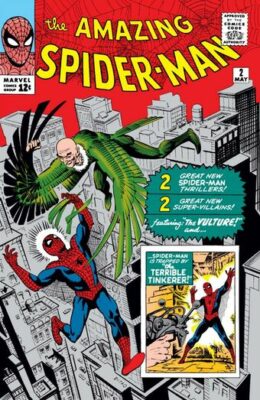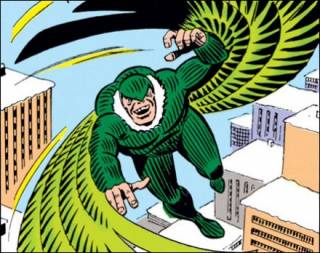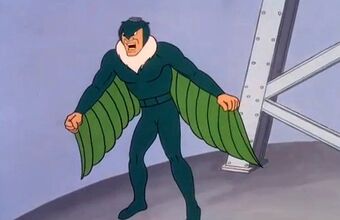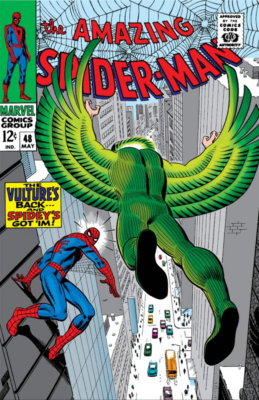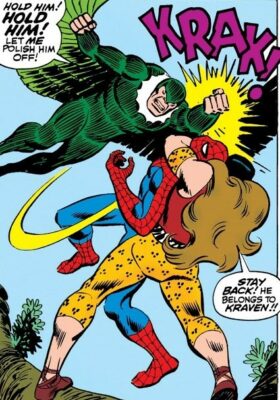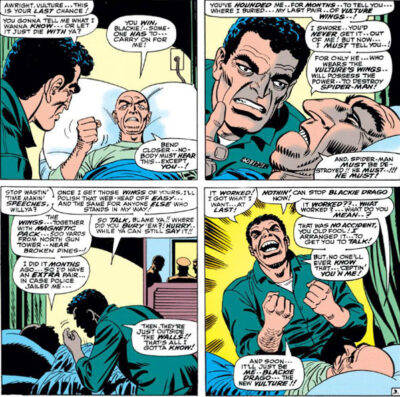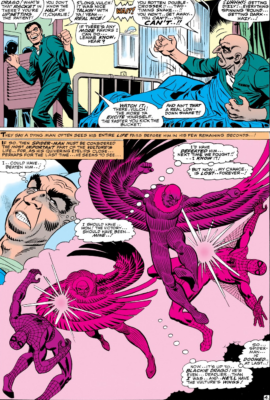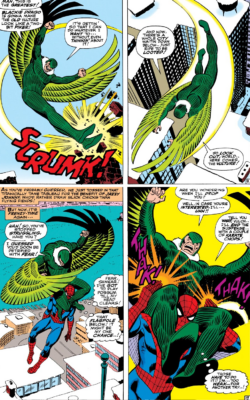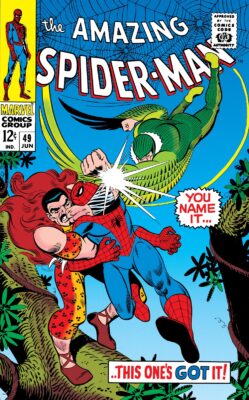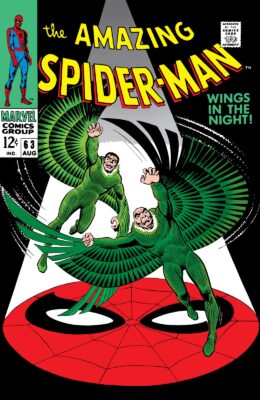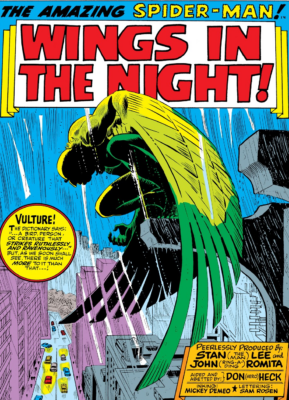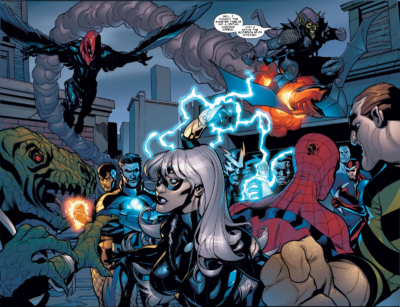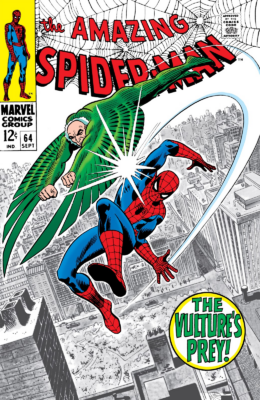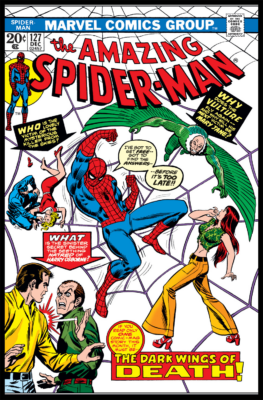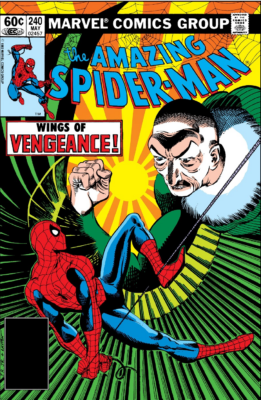Flying In and Out: Blackie Drago’s Short-Lived Vulture Career Offers Life Lessons By Anthony M. Caro
Adrian Toomes, The Vulture, might be one of Spider-Man’s most enduring and underrated villains. Silver Age and Bronze Age Spider-Man fans likely have a favorite classic story featuring the character, and the creepy, cantankerous, and menacing villain left an impression on many readers. Toomes even impressed other comic book characters so much that they “appropriated” his costume and style.
There are lessons to learn here. Toomes should have known better than to trust cellmate Raniero “Blackie” Drago, with his secrets. And Drago was foolish enough to think he’d get away with ripping Toomes off. So what if Toomes passed away? No one stays “demised” for long in a comic book.
Besides defying mortality routinely, comic books support parallel universes. Imagine Toomes’ state of mind if he found himself on an alternate earth where Blackie Drago was known as “the” Vulture, and Toomes utterly unknown.
That would have occurred had Toomes crossed into the real world in the late 1960s and well into the 1980s. Thanks to TV, Blackie Drago reached a bigger audience. Shame he couldn’t keep it.
Flying High on Television
On September 30, 1967, the fourth episode of the classic ABC Spider-Man animated series aired. The first half featured a 15-minute adventure titled “The Sky is Falling,” a fun tale that brought The Vulture to life, at least the animated version that predated Micheal Keaton’s live-action “Winged Menace” by several decades. A massive hit on Saturday morning television and, later, for decades in syndication, the original Spider-Man series retains its cult following to this day.
The series’ ability to remain faithful to the spinner rack Spider-Man character (at least during the first season) and the perfect depiction of the comic book’s villains made the show a hit. No surprise that The Vulture appeared prominently. What may surprise some modern fans is which Vulture appeared.
Although never called by his alter ego name, ABC TV/Grantray-Lawrence Animation’s villain is clearly Blackie Drago. Stan Lee and John Romita Sr. created the character in The Amazing Spider-Man #48 (May 1967) for curious reasons.
What is the backstory regarding Drago getting the TV gig over Toomes? Did Lee/Romita intend to replace Adrian Toomes and gave Grantray-Lawrence advanced notice? Or, more likely, Grantray-Lawrence came up with a different concept for The Vulture, and Lee/Romita Sr. gave the “new” Vulture some comic book continuity.
Adrian Toomes had a wonderfully creepy look and, along with Doctor Octopus, provided an excellent generation gap villain for the then high school age Spider-Man. Maybe Toomes looked too scary and garish for Saturday morning entertainment, necessitating a makeover.
Not that Blackie Drago lacked menace. The conniving and now youthful Vulture delivered a new-and-improved version of the classic villain. Drago’s rise and fall provide some entertaining reading. Although a “short-lived” and “fake” Vulture, Blackie Drago appeared in three excellent Silver Age Spider-Man stories, ones worth a second look.
The New Menace Flies into Town and Spidey’s Life
Issue 48’s story, “The Wings of the Vulture!” features the (then supposed) “last” appearance of the original Vulture and the debut of his replacement. The eye-grabbing cover had the potential to capture rack-wandering eyes, something necessary to sell comics in the old days. The Vulture’s menacing form approaches an alarmed Spider-Man, a simple cover made special thanks to subtle brilliance.
The customer can’t see The Vulture’s head, hiding the big reveal inside. Spider-Man’s alarmed face displays shock, further dropping hints something’s not what it seems.
Notice the dark inks on The Vulture’s white neck feathers? Does that not drop a hint of the dark-haired Blackie Drago?
As in the story, Drago delivers another visual change to the character. The green helmet’s addition alters the costume and further establishes the new Vulture. The helmet does more than allow Drago to “look scarier than ever” and “protect [his] head,” throwaway purposes to make the inclusion credible. (Maybe those reasons came from Grantray-Lawrence???) The helmet further sets Drago apart from Toomes. The “new” Vulture can’t be entirely like the old Vulture, or else he’s a weak imitation.
The perfect cover is a bit misleading, if not an exercise in faux news. “The Vulture’s Back and Spider’s Got ‘Im!” The original Vulture isn’t “back,” he’s in prison. The Vulture that Spider-Man faces is a new villain, and Spidey doesn’t “Got ‘Im.” Blackie Drago mops the floor with Spider-Man and does so brilliantly.
The brilliance is Lee and Romita’s doing. What better way than to present the new Vulture as a threatening menace than have him annihilate Spider-Man in their first meeting, leaving the wall-crawler knocked out while the villain flies away with ill-gotten gains?
Spider-Man does get an “out” for the loss. He didn’t expect a new villain, and he had to confront him while suffering from a cold! Take that as another nice touch of humanizing the hero while also setting up a return battle with a recovered Spider-Man, a hero ready to get even.
Don’t expect a deep and complex narrative with The Amazing Spider-Man #48, but do expect morality lessons for the reader. Lesson one: never trust a crook. Adrian Toomes and, peripherally, the reader, learn this lesson when Drago double-crosses Toomes to procure The Vulture costume’s secret location. Toomes should have known better than to trust Drago, but an obsession with defeating Spider-Man clouded his judgment. Toomes learned Drago orchestrated the elder Vulture’s life-threatening accident, but a desire for revenge blinded him.
Not that Spider-Man is immune to stubbornness. Villain on the loose or not, web-head shouldn’t be out in this kind of weather.
The snowy backdrop of a bustling New York City struggling through inclement weather reflects the best of the “little touches” that made Marvel tales so engaging back in the 1960s. Lee and Romita Sr. further used the inclement weather to provide a credible reason for Peter Parker’s cold, as well as giving younger readers a helpful heads up: sometimes you have to get going even when feeling down, out, and sick. Peter Parker could take the day off, but he sucks it up and pushes forward, not wanting to head down a path of laziness or responsibility shirking.
The “going get tough/tough get going” of lesson two precedes lesson three: know your limitations. A bad cold hampers Spider-Man’s abilities, and The Vulture knocks him out, leaving him to die in the elements.
Spider-Man’s lucky The Vulture flew away. Things could have been a lot worse. What did Spider-Man expect, though? He wasn’t 100%, but Spider-Man did expect Adrian Toomes and rushed in with an “I beat him before” feeling of confidence. Lesson four looms, don’t make assumptions.
Hopefully, both Peter Parker and Spider-Man get these lessons through their/his head(s) to turn things around next issue.
Marvel Odd Couple Team-Up
The Amazing Spider-Man #49 (June 1967) features a prophetic title, “From the Depths of Defeat!” and an oddball team-up, which started with a confrontation. Kraven the Hunter is still on the loose, and, man, is he the jealous type. After watching The Vulture on a TV set made partially of bamboo, Kraven feels slighted that the media hypes the winged one as the “city’s deadliest menace.” An unhinged Kraven runs off to confront The Vulture and re-assert his alpha-ness.
However, The Vulture only wants to steal uncut diamonds, and Peter Parker’s trying to get over a cold while 100 people dote over him, as he lies in bed hiding his Spider-Man costume under the covers. Toxic masculinity, avarice, and masturbatory metaphors all fuse to provide more lessons. Kraven did evade capture until letting his absurd ego get the best of him. The Vulture needs to embrace when to say when. And Peter Parker should know better than thinking a duplicitous double life won’t come without hassles, hang-ups, and inconveniences.
Peter Parker/Spider-Man won’t give in to the cold because he can’t let the now-battling The Vulture and Kraven “tear the city apart.” On comes the costume and off goes Spider-Man to put a stop to the villains’ mayhem.
Since Kraven and Drago only join forces when Spider-Man arrives, they make for a lousy team. The wall-crawler shakes his cold and is ready for the challenge, but he gets unlikely help. Kraven’s bungled attempt to zap Spider-Man results in taking out The Vulture, leaving lingering questions about how a one-on-one Spider-Man/Vulture confrontation would end in the hero’s favor. The ambiguity builds some tension for a future conflict.
More than a year would pass before Drago returned, and his next appearance set up an outstanding two-parter.
Innovators, Imitators, and Several Bad Wings
The cover to The Amazing Spider-Man #63 (August 1968) story “Wings in the Night!” leads readers to think Adrian Toomes and Blackie Drago choose to team up to take out Spider-Man. Not happening, as a furious, revenge-driven Toomes wants to take Drago out, and does.
Writer Stan Lee and pencilers John Romita Sr. and Don Heck craft a tale that revels in madness and anger brought to life by Adrian Toomes. Anyone who puts on a Vulture costume could be “a” Vulture. And truthfully, without a compelling personality, The Vulture could be a lame villain. Adrian Toomes’ mean streak and boiling anger allow the character to rise above gimmickry. The two-part story arc commencing starting in #63 shows how menacing the original Vulture is to Drago and Spider-Man’s chagrin.
Dark inks display “ruthless” and “ravenous” as words describing a shadowy Adrian Toomes in the ominous splash page opening issue 63. Romita Sr. and Heck’s commencing panels revealing the original Vulture’s return depict the villain as unhinged and unpredictable, a perfect story hook.
Subsequent panels featuring a swinging Spider-Man Should come with the words “tone-deaf” and “accident-prone.” Old web-head never learns a strong work ethic combined with a heart in the right place can’t compensate for terrible judgment. Spider-Man either forget or never learned the lesson of issue #48.
Web-swinging in inclement weather, a terrible idea, leads to a swing-and-fall accident and a severe shoulder injury.
Yes, Spider-Man suffers a symbolic broken wing, while two villains get literal ones back.
The previous cold-and-flu dramatic gimmick returns and does so a less silly way. An immobile arm presents a more plausible weakness, heightening tension and drama, as the reader must figure out how Spider-Man can compensate for his limitations.
As for Blackie Drago, for a hustler and a thief, he doesn’t pick up on someone else’s self-serving intentions very well. The original Vulture breaks Drago out of prison, and both he and the reader presume the action preludes a super-villain team-up. Toomes’ dismissive description of Drago as an “untalented imitator,” and himself is the “real vulture” drops hints regarding the story’s direction.
Toomes flips out on Drago immediately. Earlier in the issue, flashbacks revealed Toomes’ learned his lesson about trusting fellow crooks. Thinking Drago was his friend, he trusted the conniver. The double-cross motivated Toomes to nurse himself from prison and plan revenge. Anger over a pretender to his throne might not be the only thing pushing Toomes to rage. Putting trust in the wrong person leads to feelings of betrayal, pain, and embarrassment. Toomes has more to achieve than beating a fake Vulture. He has to punish a fake friend.
Toomes learned his lesson, and now Drago will learn his: don’t underestimate anyone. Adrian Toomes may look old and frail, but he’s a formidable and experienced villain.
Peter Parker wisely stays out of this fiasco, preferring to let them beat each other up. When the two villains almost cause a small child to fall to his death, on comes the hero costume, and Spider-Man swings into action, albeit with a bad wing.
Toomes continues to beat on Drago, and the younger Vulture allows overconfidence to lead him. Toomes is about to teach Drago a lesson here, a humiliating one. In front of a crowd, Toomes intends to reveal who’s the originator and whose the imitator. Drago learns putting on the winged costume won’t be enough. Skill, savvy, and guile make a true super-villain. The sophomore Vulture also discovers that intimate betrayals may lead to public embarrassments.
Blackie Drago suffers a thorough and disgracing thrashing. Toomes delivers a beating so severe that a mentally defeated Drago wants nothing to do with being The Vulture anymore. Readers never saw him appear as The Vulture, although he would make a cameo in Marvel Knights: Spider-Man #10 (March 2005).
Drago’s burial suggests long-term plans for the character never existed, and issue #63 served as a way to write him out and re-establish Toomes. Suspicions arise again that Drago only lived to connect to the animated series’ version of the villain.
Drago’s defeat doesn’t lead to The Vulture flying away and off to freedom and retirement. He takes notice of Spider-Man, a hero hampered by a numb arm, and wants to eliminate two nemeses in a single day.
Prey for The Vulture, Pray for the Spider
Blackie Drago meets his end, but the story doesn’t.
The Amazing Spider-Man #64 (September 1968) finds the title character trapped as “The Vulture’s Prey!” and the issue features little plot and a long, dramatic, protracted fight scene. The Vulture, flying high thanks to the confidence-boosting defeat of Drago, chooses to stay and battle Spider-Man. He comes close but can’t put the hero away.
Interestingly, after a series of twists and turns during the book-length battle, The Vulture and Spider-Man end the confrontation with a draw. Both characters end up beaten and battered, with Spider-Man getting the worst of it.
Maybe The Vulture didn’t need to learn a lesson about overconfidence. Or perhaps the villain did, as Adrian Toomes remained absent from Spider-Man books until Peter Parker, The Spectacular Spider-Man #4 (March 1977), saw him return. However, there was that odd two-parter featuring Vulture #3, Clifton Shallot, in The Amazing Spider-Man #127 (December 1973) and The Amazing Spider-Man #128 (January 1974), a curious story arc.
Departing Flight
Adrian Toomes did not appear as often as other Spider-Man villains, but the coming years saw some memorable stories featuring him. Fans who haven’t read Roger Stern’s brilliant character study of Toomes in The Amazing Spider-Man issues 240 (May 1983) and 241 (June 1983) should do so. As the Bronze Age neared its close, one of the Silver Age’s earliest villains enjoyed a near-perfect reexamination.
And what of Blackie Drago? He lived on for decades, thanks to the Spider-Man cartoon. He may appear again in future Marvel Comics’ title. The fact that he never returned in the Silver or Bronze Age represents an unfortunate missed opportunity.
Anthony M. Caro wrote the essay collection Universal Monsters and Neurotics: Children of the Night and their Hang-Ups and the sci-fi serial Why Does Cal Draw Stick Figures at 3 AM in the 22nd Century? for Amazon Kindle. He writes about all things pop culture and contributed to HorrorNews.Net, PopMatters, Mad Scientist, and Jiu-Jitsu Times. Besides working as a professional writer, he handled production duties in radio, TV, film, and theater. He’s currently developing an audio drama podcast.
essay ©2023 Anthony Caro
Join us for more discussion at our Facebook group
check out our CBH documentary videos on our CBH Youtube Channel
get some historic comic book shirts, pillows, etc at CBH Merchandise
check out our CBH Podcast available on Apple Podcasts, Google PlayerFM and Stitcher.
Use of images are not intended to infringe on copyright, but merely used for academic purpose.
Images used ©Their Respective Copyright Holders








